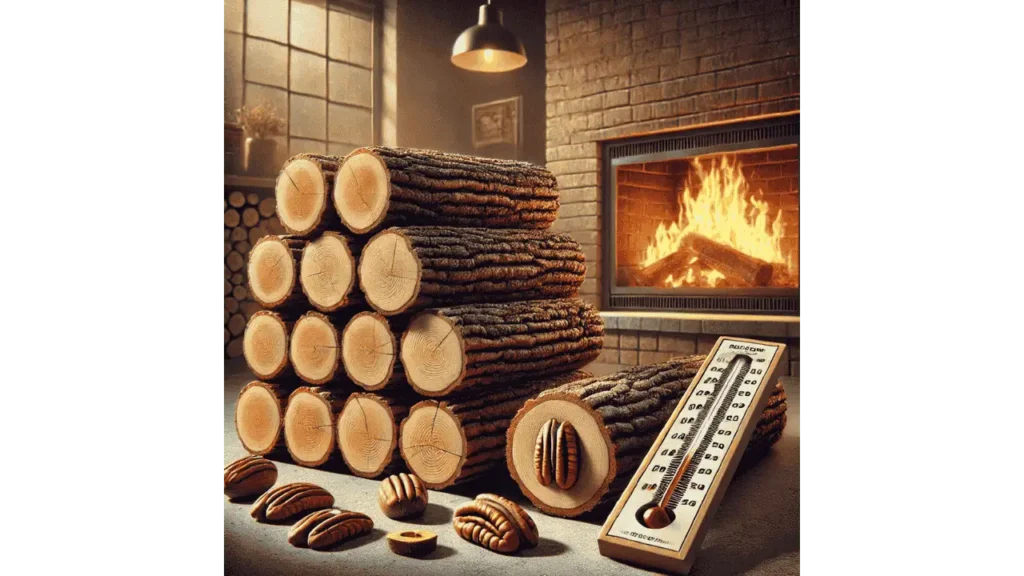Pecan wood is a hardwood known for its density, pleasant aroma, and efficient burning qualities. It belongs to the hickory family and has gained popularity among fireplace enthusiasts for its combination of heat output and unique fragrance. But is pecan wood the right choice for your fireplace? This article will explore the characteristics, benefits, and potential drawbacks of using pecan wood as firewood, along with tips for proper use and seasoning.
Understanding Pecan Wood as Firewood
To decide if pecan wood is suitable for your fireplace, it’s essential to understand its characteristics and how it compares to other firewood options.
Characteristics of Pecan Wood
Pecan wood is a dense, hard wood that burns hotter and longer than many softwoods. Its distinctive light-brown color and fine grain make it easy to identify. When burned, it produces a steady flame and a sweet, nutty aroma that enhances the ambiance of a room. These traits make pecan wood a favorite among those who enjoy both heat and fragrance.
Hardness and Heat Output
As a hardwood, pecan has a high energy content, which translates to excellent heat output. It burns slowly, providing a consistent and long-lasting fire. Compared to softer woods like pine or spruce, pecan wood generates more heat and burns for a longer time, making it ideal for colder months when sustained warmth is needed.
Benefits of Using Pecan Wood for Fireplaces
Pecan wood offers several advantages that make it a desirable option for fireplace use.
High Heat Efficiency
One of the standout benefits of pecan wood is its high heat efficiency. It burns hot and maintains a steady flame, which helps warm a room quickly and keeps it warm for an extended period. This makes pecan an excellent choice for homeowners looking to maximize the heat output of their fireplace.
Pleasant Aroma
Pecan wood is known for the pleasant, slightly sweet aroma it releases when burned. This fragrance adds to the cozy atmosphere of a home, making the fireplace experience more enjoyable. The aroma is especially appreciated during holiday gatherings or cold winter nights.
Long Burn Time
Thanks to its density, pecan wood burns longer than many other types of firewood. This long burn time reduces the need for frequent refueling, making it a convenient and efficient option for those who rely on their fireplace for warmth.
Read More: How to Stack Wood for a Fireplace?
Drawbacks of Pecan Wood
While pecan wood offers many benefits, it’s not without its drawbacks. Understanding these potential downsides can help you make an informed decision.
Creosote Buildup Concerns
Like other hardwoods, pecan wood can produce creosote, a tar-like substance that builds up inside chimneys and poses a fire hazard. Regular chimney cleaning and proper burning techniques can help minimize creosote accumulation, ensuring safe use.
Availability and Cost
Depending on where you live, pecan wood may be harder to find compared to more common firewood types like oak or maple. This limited availability can drive up its cost, making it a less economical choice for some homeowners. If you have access to a local supply, however, it can be a worthwhile investment.
How to Properly Season and Use Pecan Wood?
Proper seasoning and burning techniques are essential for getting the most out of pecan wood.
The Importance of Seasoning
Seasoning pecan wood means allowing it to dry out and reduce its moisture content, which improves its burning efficiency. Freshly cut pecan wood should be seasoned for at least six months to a year. Well-seasoned wood burns cleaner, produces less smoke, and generates more heat.
Best Practices for Burning Pecan Wood
When using pecan wood, start with small, well-seasoned pieces to build a strong base fire. Gradually add larger logs to maintain the flame. Avoid burning green or unseasoned wood, as it can produce excessive smoke and contribute to creosote buildup. Regular fireplace maintenance and proper airflow control will help you enjoy a safe and efficient fire.
Final Takeaways
Pecan wood is an excellent choice for a fireplace if you’re looking for a hardwood that offers high heat output, a pleasant aroma, and a long burn time. While it may require proper seasoning and occasional chimney cleaning to prevent creosote buildup, the benefits outweigh the drawbacks for many homeowners. If you have access to pecan wood, it can be a cozy and efficient addition to your fireplace experience.
- 25 Fireplace Decorating Ideas for Small Spaces - June 28, 2025
- How Much Heat Does an Electric Fireplace Produce? - June 27, 2025
- How to Convert a Wood Fireplace to Electric? - June 25, 2025



